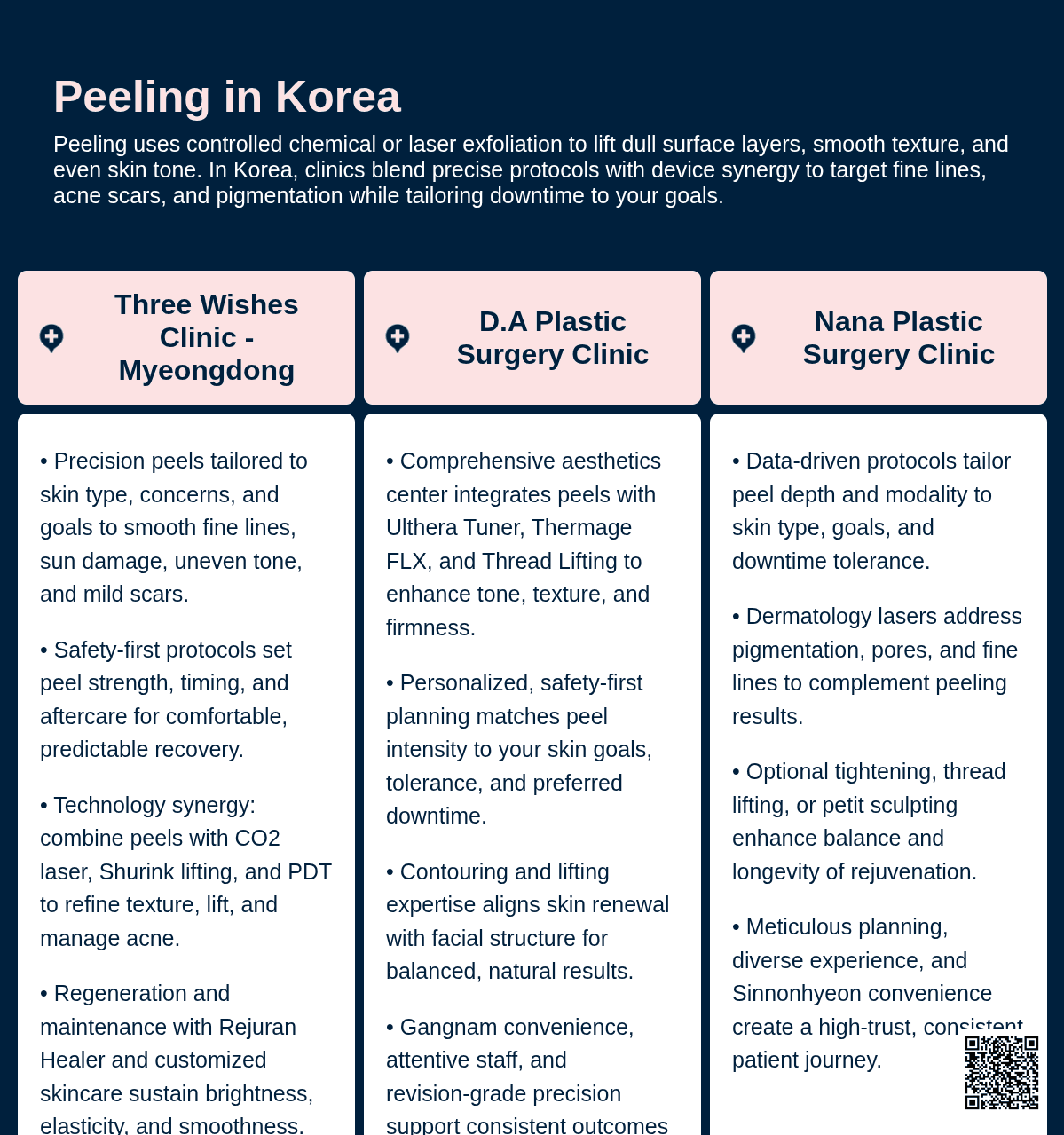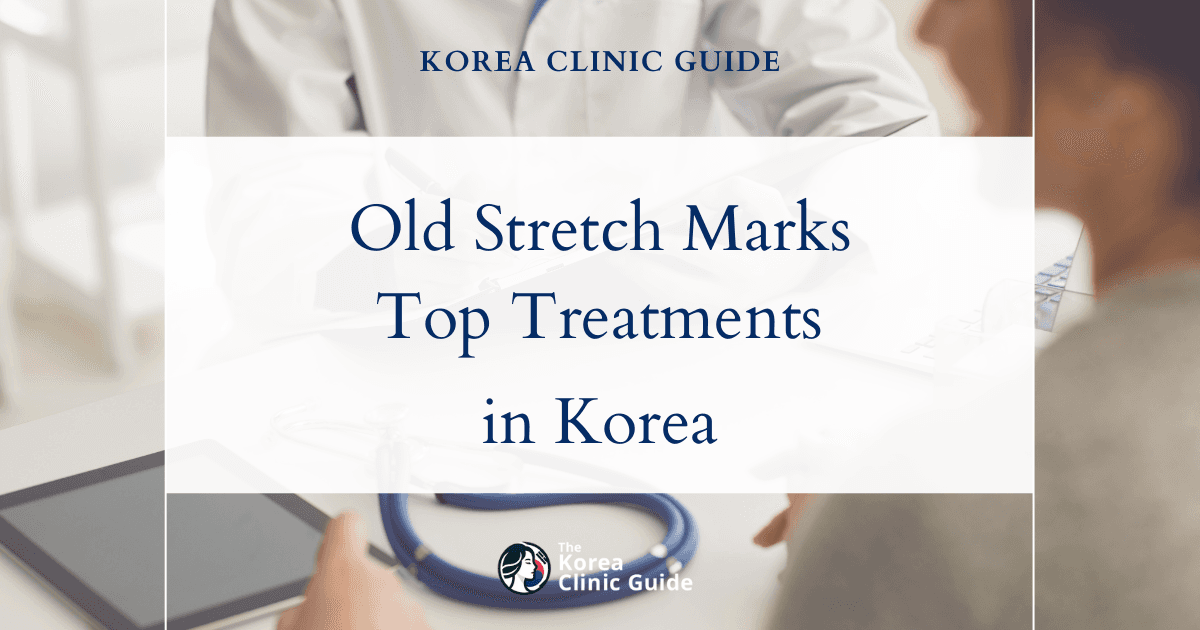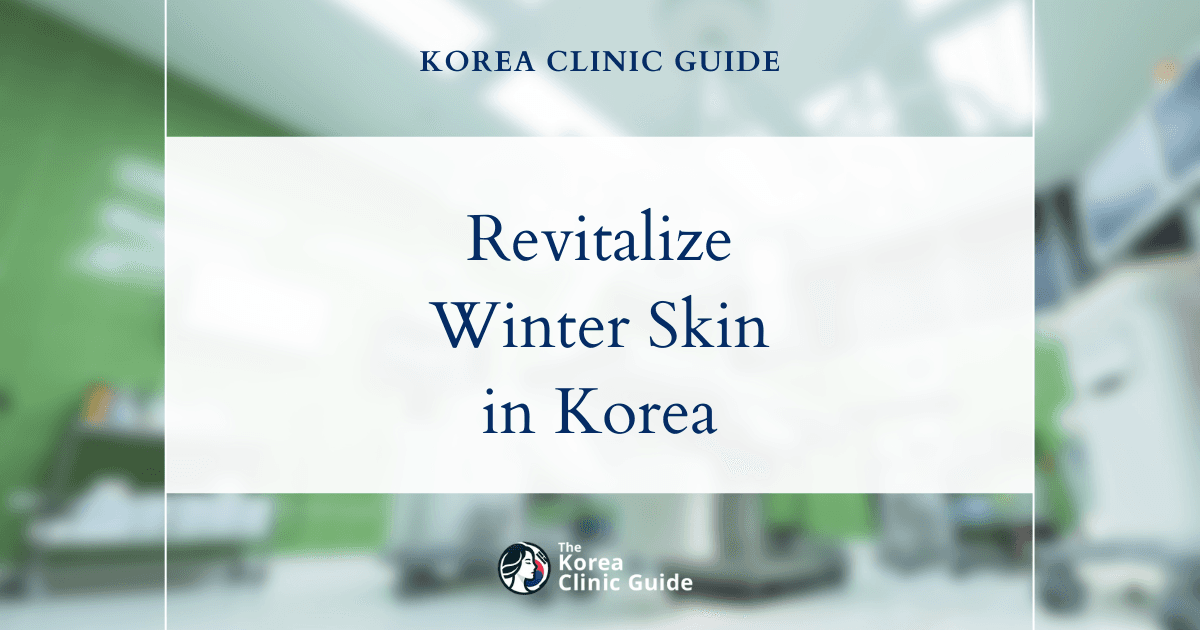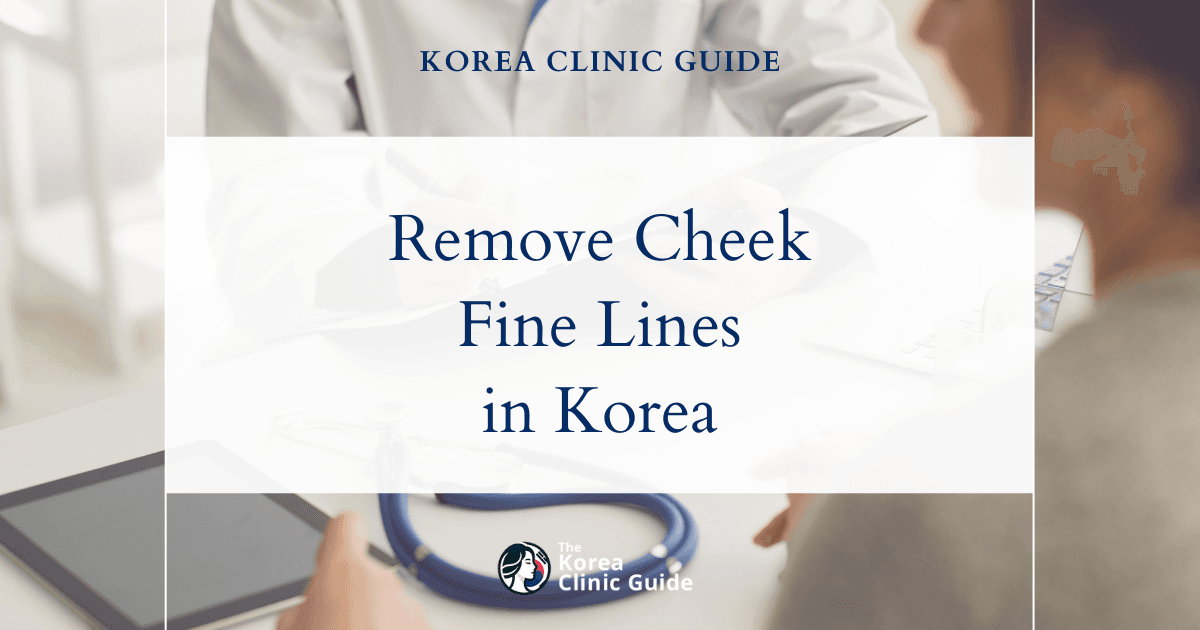Medical Tourism Blog
Chicken Skin Arms Treatment with Peeling Procedures in Korea: Effective Solutions for Smooth Skin

Table of contents
- Chemical Peeling: Rejuvenating Skin with Precision
- Best Clinics in Korea for Chicken Skin Arms
- Medical Tourism in South Korea: Getting a Chemical Peel
- Chemical Peel Costs in South Korea (and Globally)
- Real-World Effectiveness and the Patient Experience
- Conclusion
- References
Considering treatment in Korea? Everything you need to know e.g. — how to avoid scams, visas, interpreters, recovery tips — in our Medical Tourism Master Guide. Plan with confidence in minutes, not weeks!
Keratosis Pilaris (KP), often called "chicken skin arms," is a common and harmless skin condition that shows up as dry, rough patches with tiny, painless bumps. These bumps usually appear on the upper arms, thighs, cheeks, and buttocks, but can also occur on the forearms, lower legs, and faces—especially in children. The texture can feel like sandpaper or look like goosebumps.
KP is caused by a buildup of keratin, a protein meant to shield the skin from outside threats. In KP, keratin clogs hair follicles, resulting in that distinct bumpy texture. While it’s not usually painful, the affected skin can be dry or itchy.
A few factors can make KP worse: dry air, especially in winter, genetics (it often runs in families), and links to other conditions like eczema. There may even be a connection to Vitamin A deficiency. Many people notice KP fading by age 30, but it can linger or fluctuate with the seasons.
KP can affect more than just skin—it often impacts self-image and quality of life. In fact, studies say over 40% of KP sufferers feel it affects their confidence, which may lead to embarrassment, anxiety, or depression, especially when it’s visible. Even though doctors consider KP medically benign, its emotional effects are valid and often drive people to seek treatment.
Chemical Peeling: Rejuvenating Skin with Precision
Chemical peeling is a popular dermatological technique for smoothing skin and improving texture. It works by applying a chemical solution to exfoliate the skin’s upper layers, encouraging new cell growth and natural healing.
This process removes dead or damaged cells—including the keratin plugs that define Keratosis Pilaris—and reveals healthier, brighter skin below. The treatment can even out pigmentation and speed up cellular turnover.
Types of Chemical Peels for Keratosis Pilaris
Chemical peels come in different strengths:
- Superficial Peels: Target the outer skin layer; minimal downtime and best for mild skin blemishes.
- Medium Peels: Reach deeper into the dermis, treating moderate imperfections.
- Deep Peels: Penetrate the lower dermis for severe issues, but involve more downtime and higher risks.
For Keratosis Pilaris, superficial to medium peels are most common—they strike a balance between effectiveness and recovery time.
Key Chemical Agents in Peels for KP
- Alpha Hydroxy Acids (AHAs):
- Lactic Acid: Known for gentle exfoliation with minimal irritation; good for sensitive skin and acts as a moisturizer. A 10% solution helps exfoliate and brighten.
- Glycolic Acid: Breaks down cell bonds to clear keratin buildup, used in concentrations from 50% to 70% for significant improvement in KP papules, redness, and pigmentation.
- Beta Hydroxy Acids (BHAs):
- Salicylic Acid: Penetrates deep into pores, dissolving keratin plugs and smoothing out skin; typically used between 0.5% and 30%, with 3% a common starting point.
- Trichloroacetic Acid (TCA): A stronger agent, goes deeper and helps with scars and discoloration; best for more resistant KP.
- Blended Peels: Formulas like "The Perfect Peel" and "VI Peel Precision Plus" mix ingredients like Glutathione, Kojic Acid, Salicylic Acid, TCA, Vitamin C, and Retinoic Acid for a broad range of benefits.
Choosing the right peel for KP is never one-size-fits-all. Each acid has its properties; lactic acid is milder, while salicylic acid is best for oily, clogged skin. Therefore, selecting a peel requires a dermatologist’s assessment to adapt the peel type and concentration to the patient’s specific severity, skin sensitivity, and recovery needs.
Best Clinics in Korea for Chicken Skin Arms
Listed below are the best clinics in Korea for chicken skin arms:
| Clinic Name | Key Features | Special Techniques |
|---|---|---|
| Nana Plastic Surgery Clinic | Advanced aesthetic procedures; extensive clinical data and diverse surgical experience; comprehensive portfolio (dermatology, facial contouring, body sculpting, lifting, nose, eye, breast); integrated approach to skin quality and arm shape; minimal downtime; personalized treatment plans; convenient access and continuity at Sinnonhyeon Station | Laser-led skin refinement targeting rough texture and redness; non-surgical tightening/skin-firming therapies; comprehensive arm aesthetics with arm/thigh lift and targeted liposuction; combined dermatologic care with surgical options |
| D.A Plastic Surgery Clinic | Wide array of advanced cosmetic procedures; skilled team and dedicated staff; personalized services in a safe, comfortable environment; integrated skin-and-body approach; personalized care plans; safety and comfort first; comprehensive aesthetic expertise (face, body, eye, nose, breast, lifting); convenient Gangnam Station location | Non-surgical Skin Elasticity Treatment; Ulthera Tuner; Thermage FLX; precise upper-arm liposuction |
| Modelo clinic | Values-driven, individuality-first philosophy; does not follow trends; long‑term value and natural-looking, personalized plans; Asian skin expertise; layered, comprehensive care; gradual, progressive refinement; comfort-focused, minimally invasive solutions with reduced downtime | Wrinkle and Contour Botox (optimized for Asian skin and facial structures); fillers (full-face and under-eye “baby” filler); advanced skin programs (lifting and whitening using lasers and combination therapies); Comfort Thermage; thread lifting; Bodytoxin; laser-based complexion refining |
Nana Plastic Surgery Clinic
Nana Plastic Surgery Clinic, located at Sinnonhyeon Station, is renowned for advanced aesthetic procedures supported by extensive clinical data and diverse surgical experience. With a comprehensive portfolio spanning dermatology, facial contouring, body sculpting, lifting, nose, eye, and breast procedures, Nana delivers an integrated approach to both skin quality and arm shape—making it a premier destination for patients seeking smoother, more even-toned “chicken skin” arms with minimal downtime.
- Evidence-based excellence: Protocols are backed by extensive clinical data and a broad track record across surgical and dermatologic treatments.
- Laser-led skin refinement: A range of laser treatments targets rough texture and redness on the upper arms with minimal downtime and effective results.
- Non-surgical tightening: Skin-firming therapies complement laser work to improve arm smoothness and overall feel.
- Comprehensive arm aesthetics: For combined concerns (texture plus contour or laxity), arm/thigh lift and targeted liposuction can be integrated with dermatologic care for complete arm rejuvenation.
- Personalized treatment plans: Care is tailored to skin type, severity, and goals, combining lasers, tightening, and non-invasive slimming when appropriate.
- Convenient access and continuity: Centrally located at Sinnonhyeon Station for easy consultations and follow-up care.
Find more about this clinic here: Nana Plastic Surgery Clinic Website
D.A Plastic Surgery Clinic
DA Plastic Surgery Clinic, located at Gangnam Station, offers a wide array of advanced cosmetic procedures designed to enhance your natural beauty. With a skilled team of surgeons and dedicated staff, the clinic provides personalized services in a safe, comfortable environment. From face and body contouring to innovative skin treatments, DA delivers comprehensive, tailored care—making it a standout destination for individuals seeking smoother, more refined-looking “chicken skin” arms.
- Integrated skin-and-body approach: a broad menu of skin and body procedures enables customized plans to improve arm texture and overall contour.
- Skin quality focus: non-surgical Skin Elasticity Treatment, along with advanced technologies such as Ulthera Tuner and Thermage FLX, supports improvements in tone, firmness, and the appearance of roughness.
- Arm contour synergy: when appropriate, precise liposuction of the upper arms can complement skin therapies to create a more even, refined silhouette.
- Personalized care plans: the skilled surgical team and dedicated staff tailor step-by-step treatments to your skin type, goals, and downtime needs.
- Safety and comfort first: treatments are delivered in a safe, comfortable setting designed to maximize patient confidence and care continuity.
- Comprehensive aesthetic expertise: access to facial, body, eye, nose, breast, and lifting procedures ensures results that harmonize with your overall look.
- Convenient Gangnam Station location: easy access for consultations, procedures, and follow-up visits.
Find more about this clinic here: D.A Plastic Surgery Clinic Website
Modelo clinic
Modelo Clinic in Korea is a values-driven aesthetic center that does not follow trends; instead, it pursues beauty that grows with you, maximizing your long‑term value by celebrating your beautiful individuality. With a comprehensive portfolio spanning Botox (wrinkle and contour techniques optimized for Asian skin and facial structures), fillers (full-face and under-eye “baby” filler), advanced skin programs (lifting and whitening using lasers and combination therapies), and non- to minimally invasive technologies (Comfort Thermage, thread lifting, Bodytoxin), Modelo designs natural-looking, personalized treatment plans that honor your unique features and enhance skin quality over time.
- Why Modelo is the best choice in Korea for Chicken Skin Arms:
- Individuality-first philosophy: Rather than chasing trends, the clinic builds customized, long‑term plans to refine texture and tone gradually—ideal for concerns like chicken skin arms that benefit from steady, natural improvement.
- Asian skin expertise: Procedures such as Wrinkle and Contour Botox are designed for Asian skin and facial structures, reflecting the clinic’s nuanced approach to achieving balanced, harmonious, and natural results in all treatments.
- Advanced skin technologies for smoother-looking skin: Tailored skin programs incorporate lifting strategies and whitening protocols that use various laser and combination treatments to improve clarity and promote a smoother appearance; Comfort Thermage adds tightening and smoothing with a focus on patient comfort and gradual results.
- Layered, comprehensive care: From energy devices (Comfort Thermage) to laser-based complexion refining and supportive minimally invasive options (thread lifting), the clinic can sequence treatments to address both texture and tone around the arms for a more refined look.
- Natural-looking outcomes over time: Immediate improvements are available with certain modalities (for example, fillers show instant volumization in facial applications), while technologies like Comfort Thermage and thread lifting deliver progressive benefits—an approach that aligns with the slow-and-steady refinement needed for chicken skin arms.
- Comfort-focused, minimally invasive solutions: Non-invasive and minimally invasive options reduce downtime while maintaining a high standard of safety and patient comfort, supporting consistent treatment adherence and better long-term skin quality.
Find more about this clinic here: Modelo clinic Website
Medical Tourism in South Korea: Getting a Chemical Peel

South Korea is renowned for its advanced cosmetic procedures and dermatology expertise, often at 30–50% lower prices than Western countries, thanks to a competitive market and robust local manufacturing. Many clinics cater to international visitors with English-speaking staff and streamlined processes.
What to Expect: The Chemical Peel Process for Medical Tourists
-
Initial Contact and Consultation: Most patients connect via email or phone, with consultations often costing $50–$150. A thorough skin diagnosis is done, sometimes involving high-tech equipment, leading to a tailored plan (type of peel, number of sessions, intervals between treatments).
-
Booking and Preparation: A deposit (usually about 10%) secures the appointment. Pre-peel instructions are provided, like stopping certain skin products a week before the procedure.
-
The Peeling Procedure: Chemical solutions are carefully applied, varying in application time and strength. Popular Korean options for KP include:
- Aladdin Peel: Uses coral calcium micro-needles to exfoliate and boost regeneration, effective for arms, back, and chest without chemical side effects.
- Opal Peel and Aqua Peel: More potent than at-home peels; Aqua Peel combines exfoliation with hydration, great for sensitive skin.
- Salicylic Acid Macrogol Peeling: Clinic-based, uses 30–40% concentration and stays on the skin for about 10 minutes.
- Tranex Reti Peel: More intense, left on for up to 2–6 hours in clinic/home, offering greater results but with higher side-effect risks.
Clinics sometimes offer bundled packages—light chemical peels paired with lasers, stem cell treatments, and masks for holistic care.
-
Aftercare and Recovery: Proper aftercare is key. Patients are advised to let peeling skin shed naturally, use daily sunscreen, rely on mild cleansers and oil-free moisturizers, and avoid intense exercise or saunas for 2–3 days. Recovery from medium peels may last 7–14 days (redness can persist longer), while superficial peels usually heal within a week.
Take-home aftercare kits are often provided, including masks and moisturizers. The full effect can take months to appear, but Korea’s comprehensive care system aims to support patients throughout.
Chemical Peel Costs in South Korea (and Globally)
Typical Chemical Peel Prices in South Korea
Costs in South Korea vary based on peel depth, clinic prestige, products, and practitioner experience:
- $50–$200 USD per session (₩72,800–₩291,300 KRW), with some reaching $800 USD for deeper, more exclusive treatments.
- Aqua Peels: $100–$300 USD per session.
- Initial Consultations: $50–$150 USD.
- Cosmetic peels usually aren't covered by insurance.
How South Korea Compares Internationally
Korea’s chemical peel prices are typically much lower than the US or Europe. For example, a treatment costing over $1,000 stateside may cost $500 in Seoul. Below is a global cost comparison:
| Country | Chemical Peel Cost Range (USD) | Notes |
|---|---|---|
| South Korea | $50 - $800 | Varies by type, depth, clinic reputation, district location |
| USA | $200 - $6,000 | Light peels $100–$300; deep peels add anesthesia/facility fees |
| Mexico | $175 - $1,000 | Light/medium $175; deep peels up to $1,000, sometimes surgical |
| Turkey | $450 - $8,000 | Quality/safety vary; post-care may be extra |
| Canada | $200 - $1,000 | Extra fees for add-ons/requirements |
| Australia | $200 - $5,500 | Additional consultation and aftercare fees possible |
| United Kingdom | $200 - $6,000 | Expertise level affects cost |
| Japan | $150 - $5,750 | Dependent on expertise/facility reputation |
| UAE | $175 - $5,000 | Higher sophistication drives up costs |
| Thailand | $25 - $594 | Wide range; post-care quality can vary |
Travel costs also add up: flights to Korea may cost $600–$1,500, accommodation $30–$250/night, local transit $1.50–$4.50 per ride, and meals $5–$15. Medical tourists should account for these when budgeting.
Real-World Effectiveness and the Patient Experience
Many with Keratosis Pilaris experience real improvements after chemical peels. Patients frequently report smoother, clearer skin, less redness, and raised confidence ("my arms had never felt more smooth!"). It’s described as "intense exfoliation" with quick, noticeable results.
Clinical studies back this up: for instance, one showed that 50–70% glycolic acid peels led to a 60% reduction in bumps by day 80—plus improvements in pigmentation and redness. Seventy-six percent of study participants saw improvements with no worsening.
Yet, KP is persistent; several years after treatment, results often fade, and regular maintenance is needed. Peels manage KP, they don’t cure it. Patients online often ask if “the KP came back”—ongoing care is usually needed. Side effects can include redness, dryness, or mild irritation, mostly for a few days. Rarely, deeper peels can cause scarring, pigment changes, or infections—especially in darker skin tones. Deep treatments require skilled professionals due to possible organ risks.
Importantly, improving KP can also boost self-esteem. By tackling its visible symptoms, many report reductions in anxiety and better body satisfaction—proving the emotional impact of this “benign” ailment.
Conclusion
Keratosis Pilaris impacts confidence and comfort, but chemical peeling provides an effective solution—especially when personalized to skin type and symptom severity. South Korea’s blend of affordability, technology, and patient-centered care makes it a leading choice for KP treatment. While peels offer clear short-term improvements, ongoing maintenance is key for lasting results. Consulting with a qualified dermatologist and considering the full scope of costs and aftercare are essential for a safe, satisfying medical tourism experience.
References
1, 2, 3, 4, 5, 6, 7, 8, 9, 10, 11, 12, 13, 14, 15, 16, 17, 18, 19, 20, 21, 22, 23, 24, 25, 26, 27, 28















